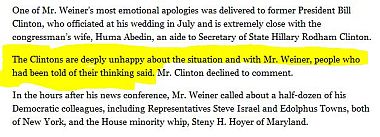
HOW MANY ANONYMOUS SOURCES? The NYTimes writes: "The Clintons are deeply unhappy about the situation and with Mr. Weiner, people who had been told of their thinking said." How many unnamed "people" are referred to here? Two or six? And why are they anonymous? The NYT anonymous source policy clearly states a reason for granting anonymity must be stated.
Where’s the New York Times’ anonymous source policy?
iMediaEthics spotted a particularly loose use of sources in the Times’ June 7 article on the response to Rep. Anthony Weiner’s press conference revealing he has carried on online relationships while in office and while married and confirming he did send a photo of his “bulging boxers” to a college student recently.
The article did report several named sources commenting on their reactions to Weiner’s admission or conversations with Weiner about his actions. iMediaEthics counted seven named sources: New York representatives to Congress Nydia M. Velázquez and Edolphus Towns , Senate Majority Leader Sen. Harry Reid, (D-NV) campaign fundraisers Leena Doshi and Zina Sapir, Justin Shapiro and graduate student Anna Bean.
Even though seven sources were named, this still prompts questions for the New York Times. For example: Who is Anna Bean? Just a graduate student? How about Justin Shapiro? Does either of them have any relationship or connection with Rep. Weiner, his campaign, politics, anything? A Google search of their names with Weiner’s only produces their comments to the Times.
Now, for those anonymous sources: By StinkyJournalism’s count, The Times cited at least ten anonymous sources, but because in two instances the Times describes those anonymous sources vaguely as “people,” StinkyJournalism and the public don’t know how many “people” made comments to the Times. For the sake of our count, we’re assuming two sources constitute people.
And, there are varying degrees of descriptions. A spokesperson for actor Matt Damon isn’t too vague, although iMediaEthics thinks the Times should have named the spokesperson.
But, how about this anonymous source description. “People who had been told of [former President Bill Clinton and Secretary of State Hillary Clinton’s] thinking?” Huh? Did the Clintons tell these “people” what they were “thinking?” Did someone else tell these “people” what the Clinton’s were “thinking”?
As the New York Times’ — and other news outlets’ — anonymous source policy calls for careful use of anonymous sources with sufficient description of sources’ relationship to the matter on which they are commenting, iMediaEthics was a bit confused by the vague descriptions. See below the list of anonymous sources cited and the various descriptions provided by the Times for their use:
- “a contributor who spoke” with Weiner and “spoke on the condition of anonymity because of the uncertainty surrounding the congressman’s future.”
- “two people briefed on the conversations” between “Some New York Democrats” and “former Councilman Eric N. Gioia”
- “a senior Democratic Congressional official”
- ” people who had been told of their thinking” of the Clintons
- people “who spoke with Mr. Weiner” suggesting “Democratic colleagues.”
- a Weiner spokesperson who “declined” to talk
- a spokesperson for Matt Damon
The New York Times’ anonymous source policy (see here) notes that journalists must both “convince a reader of [the source’s] reliability” and detail any motivations the source may have.
According to that policy, an example of a reason to grant anonymity is if the source “may face legal jeopardy or loss of livelihood for speaking with us.” Describing a source as someone “who spoke with” Rep. Weiner certainly doesn’t help readers, in iMediaEthics’ view. The source could be anyone! Adding the suggestion the source may be a “Democratic colleague” doesn’t narrow the playing field down at all.
iMediaEthics is writing to the New York Times for comment and will update with any response.






